In-Plane Instability of Parabolic Arches under Uniformly Distributed Vertical Load Coupled with Temperature Gradient Field
Abstract
In civil engineering, arches, such as steel arch roofs and arch bridges, are often subjected to linear temperature gradient field. It is known that the in-plane instability of parabolic arches is caused by the significant axial force. The arch under the linear temperature gradient field produces complex axial force, and so the instability of arches would be affected by temperature gradient field significantly. However, the analytical solutions of in-plane instability of parabolic arches being subjected to the uniformly distributed vertical load and the temperature gradient field are not solved in the opening literature. In this paper, in-plane instability of a fixed steel parabolic arch under linear temperature gradient field and vertical uniform load is analyzed theoretically. Firstly, the cross-sectional effective centroid and effective stiffness of the cross section for arches under the linear temperature gradient field are derived. Secondly, the preinstability internal force analysis of the parabolic arch under the linear temperature gradient field and the vertical uniform load is carried out based on the force methods. Novel theoretical solutions for in-plane instability load for fixed steel parabolic arches under the linear temperature gradient field and the vertical uniform load are obtained. It is found that the gradient temperature, slenderness, and rise-span ratio have important influences on the critical in-plane instability load of the shallow parabolic arch, while there is no significant effect on the deep parabolic arch.
1. Introduction
Long-span steel arch structures are widely applied to engineering, for instance, long-span steel roofs of the terminal, long-span steel arch bridge, etc. For large-span steel roofs, the temperature inside and outside of the roof is different due to sun exposure. In summer, the temperature inside the structure is lower than that outside the structure, while in winter, the temperature inside the structure is higher than that outside the structure. The inconsistence of internal and external temperature will produce linear gradient temperature field and internal force to the structure, and the linear gradient temperature field and internal force affect the bearing capacity of the structure. Except for the linear gradient temperature field caused by solar irradiation, the fire inside the structure will cause the internal temperature of the structure to be higher than the external temperature and then generates the linear gradient temperature field. Hence, the study of the steel arch structure under linear temperature gradient field has a profound significance on the fire resistance design of the steel arch structure.
Many scholars have conducted a series of research studies on the buckling of steel arch structures. Pi and Trahair. [1] studied the inelastic lateral buckling strength and design of steel arches under general loading using an advanced nonlinear inelastic finite element method of analysis. Mallon et al. [2] researched the influence of the initial curvature of thin shallow arches on the dynamic pulse buckling load. Moon et al. [3] investigated the geometrically nonlinear behavior of pin-ended shallow parabolic steel arches subjected to a vertically distributed load for assessing the buckling load. Pi and Bradford. [4] researched the dynamic in-plane buckling of a shallow pin-ended circular arch under a central radial load that is applied suddenly with infinite duration. Bradford et al. [5] researched the prebuckling behavior of a pin-ended circular arch under a uniform radial load. Han et al. [6] researched the in-plane nonlinear behavior and stability of shallow circular arches with elastic horizontal supports under a uniform radial load by the principle of virtual work. Zeng et al. [7] studied the stability analysis of elastic restrained arc steel arch under concentrated load. Kang et al. [8] conducted a dynamic response analysis of an elastically supported arc steel arch structure under blast impact loading. Yan et al. [9] researched a nonuniform shallow arch characterized by three constant stiffness regions under a central concentrated load. Li et al. [10] established an analytical solution to predict the buckling load of the thin-walled arch under a point load at midspan position. Fan et al. [11] carried out an analytical study and a numerical simulation on the nonlinear in-plane buckling behavior of the shallow parabolic steel arches with tension cables and pin joints. Pi and Bradford [12] researched the nonlinear thermoelastic buckling behavior of articulated shallow arc steel arches under the impact of linear temperature gradient field. Bouras and Vrcelj. [13] carried out the nonlinear elastic prebuckling and in-plane buckling analysis of the circular shallow arches under a uniformly distributed load and time-varying uniform temperature field. Song et al. [14] analyzed an in-plane jump buckling and bending behavior for arc steel arches subjected to fire. Asgari et al. [15] theoretically researched the nonlinear thermoelastic behavior of pin-ended functionally graded material (FGM) circular shallow arches. Li and Zheng, [16] investigated the buckling of confined thin-walled functionally graded material (FGM) arch subjected to external pressure. Tang et al. [17] researched the in-plane asymmetric buckling of the heated functionally graded material (FGM) circular arches under uniform pressure fields. Li et al. [18] researched the analytical process of the functionally graded porous (FGP) arch structure in an elevated thermal field. Cai et al. [19] researched the in-plane stability of rotationally restrained parabolic shallow steel arches under a vertical uniform load and temperature changes below 100°C and used the virtual work principle method to establish the nonlinear equilibrium and buckling equations. Pi and Bradford [20] researched nonlinear in-plane buckling of circular arches being subjected to uniform radial and thermal loading. However, only a few scholars have researched the parabolic steel arches under the temperature field, especially the effect of temperature gradient field. Parabolic arches are widely used in practical engineering. The internal force analysis and stability analysis of parabolic arches are important parts of arch design, construction and maintenance, etc. However, the analytical solutions of in-plane instability of parabolic arches being subjected to uniformly distributed vertical load and temperature gradient field are not solved in the opening.
Hence, this paper derives the cross-sectional effective centroid and effective stiffness for parabolic arches under the linear temperature gradient field and obtains the axial and bending actions of parabolic arches under linear temperature gradient field coupled with vertical uniform load. In addition, the analytical solution of the critical load for in-plane instability of the parabolic arches under temperature gradient field coupled with vertical uniform load is also obtained, and it is verified by the numerical simulations software ANSYS.
2. Analysis of Geometrical and Material Properties of Parabolic Arch
2.1. Basic Analysis
2.1.1. Mechanical Model
The fixed parabolic steel arch under linear gradient temperature field coupled with vertical uniformly distributed load is considered as the study object, which is plotted in Figure 1.
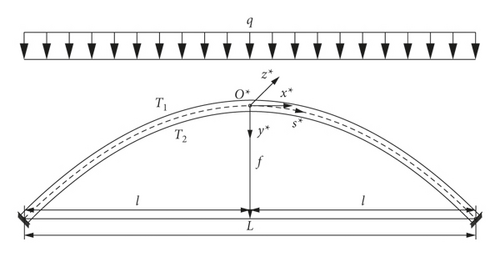

o∗x∗y∗z∗ denotes the initial coordinates of the parabolic steel arch, o∗ is situated in the cross-sectional geometric center of vault, and o∗x∗, o∗y∗, and o∗z∗ are the horizontal coordinate axis, the vertical coordinate axis, and the lateral coordinate axis of the initial coordinates, respectively. o∗s∗ is the geometric centroid axis of the initial coordinates. Figure 1(a) shows that f, L, l, and S are the rise, span, half-span, and length of the parabolic steel arch, respectively. Figure 1(b) shows that T1 and T2 are top and bottom cross-sectional temperatures, respectively. h represents the cross-sectional height.
2.1.2. Basic Hypothesis
- (1)
The environment temperature is 20°C.
- (2)
Cross-sectional temperature, parabolic arch deformation, temperature dilatation factor a, and Poisson’s ratio v are independent of time.
- (3)
The temperature T of the cross section of the arch varies uniformly along the o∗s∗ axis and the o∗x∗ axis and linearly along the o∗y∗ axis, as shown in Figure 2, where T1 < T2.

2.1.3. Modulus of Elasticity
Figure 3 shows the influence of temperature on steel elastic modulus. As shown in the picture, steel elastic modulus decreases with the an increase of material temperature, and the value decreases more remarkably with the augment of temperature.
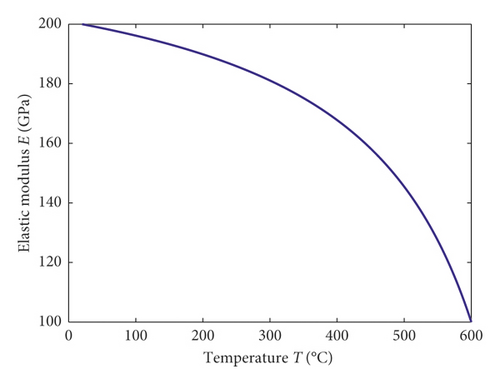
2.1.4. Effective Stiffness and Effective Centroid
The I section is taken as the cross section of parabolic steel arch studied in this paper, and when the parabolic steel arch is under the linear gradient temperature field, the elastic modulus changes along the o∗y∗ axis, and the vertical coordinate of effective centroid also changes. Therefore, the effective coordinate system oxyz can be determined by the location of the effective centroid, which is shown in Figure 4.
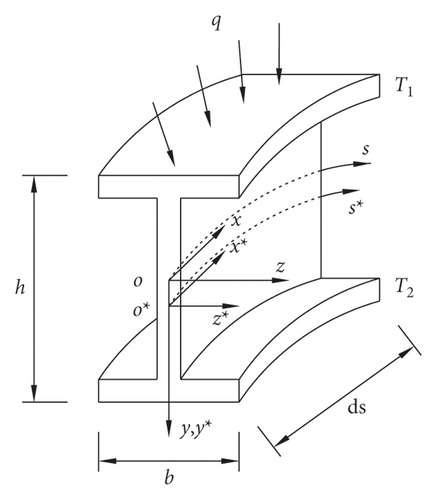
The effect of linear gradient temperature field on the effective center of parabolic arch cross section is shown in Figure 5, and it can be seen that the effective center of shape is shifted to the side with lower temperature under linear gradient temperature field, and the effect of gradient temperature on the I section is greater than that on the rectangular section.
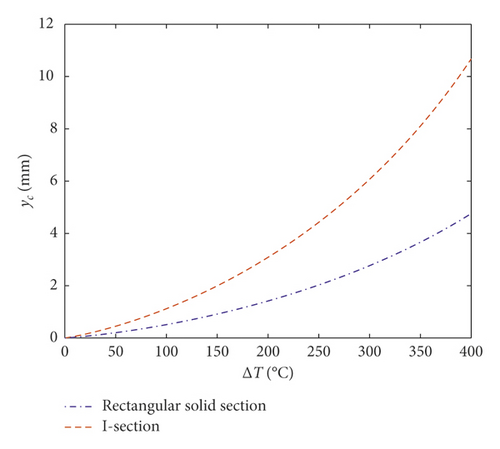
3. Results and Discussion
3.1. Internal Force Analysis
The accurate solutions of the preinstability axial force N and bending moment M of a parabolic steel arch are essential for the in-plane instability of the arch. However, no accurate solutions of internal forces for arches being subjected to linear temperature gradient filed and vertical uniformly distributed load q can be obtained in the opening literature. The internal force of the arch can be solved by the force method which is based on Castigliano’s theorems, and when an arch is under linear temperature gradient field coupled with vertical uniformly distributed load q, the internal forces for the arch can be herein calculated by the force method in this paper.
Based on the force method, the parabolic steel arch is cut into two pieces at the top, which is shown in Figure 6. These two parts are the statically determinate structures with unknown additional axial forces (Nc), bending moment (Mc), and shear force (Qyc). However, according to the principle of structural symmetry, the unknown additional shear force (Qyc) is equal to zero.
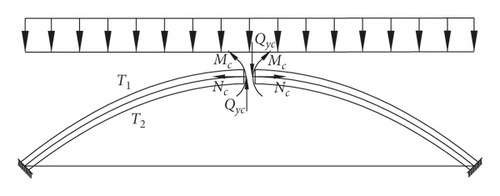
Hence, the accurate solutions of axial force N and bending moment M can be obtained by substituting (27) and (28) into (25) and (26).
In order to expound the effect of the linear temperature gradient field on N and M in (23) and (24), the changes of Nc and Mc with rise-span ratio f/L for parabolic arches having temperature difference between the top and base of the cross section ΔTg (i.e., ΔTg = 50°C, 100°C, 150°C) are shown in Figures 7(a) and 7(b), respectively, where Nc and Mc are the central axial and bending actions, and Ta = 200°C, q = 2 × 105 kN/m, and L/γx = 30 with γx being the radius of gyration of the arch. Beyond that, the changes of Nc and Mc with rise-span ratio f/L for parabolic arches having different average temperatures of the cross section Ta (i.e., Ta = 150°C, 200°C, 250°C) are plotted in Figures 7(c) and 7(d), respectively, where ΔTg = 100°C, q = 2 × 105 kN/m, and L/γx = 30.
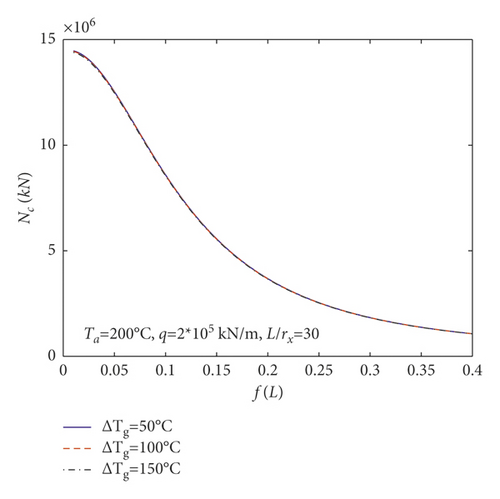
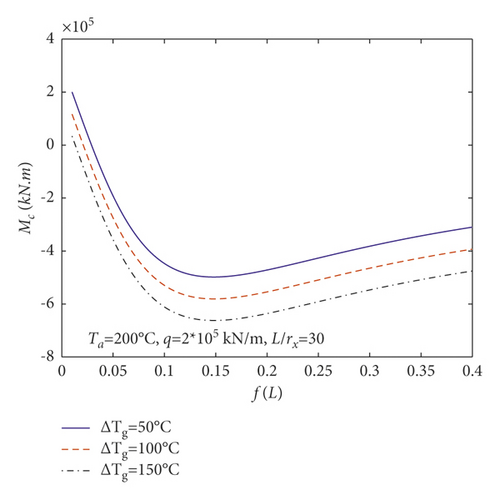
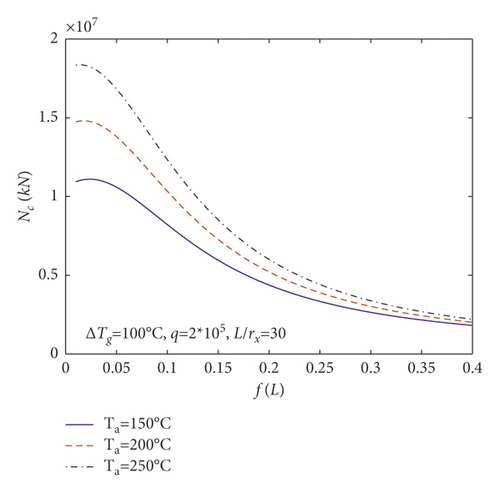
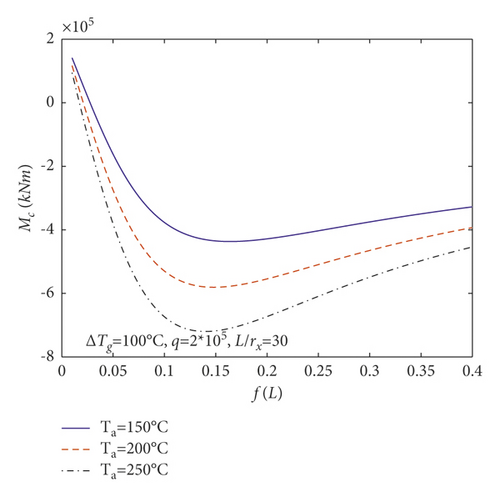
According to Figure 7(a), Nc almost does not change for parabolic arches having different ΔTg, which is consistent with (27) without ΔTg. Figure 7(a) also reveals that Nc augments as the rise-span ratio f/L augments at the beginning; after that, it decreases as the rise-span ratio f/L augments in case the rise-span ratio of arches reaches to a certain value. Figure 7(b) shows that Mc decreases as the temperature difference between the top and bottom of the arch section ΔTg augments. Figure 7(b) also shows that Mc decreases as the rise-span ratio f/L augments initially; after that, it augments as the rise-span ratio f/L augments in case the rise-span ratio of arches reaches to a certain value. Figure 7(c) shows that Nc augments as the average temperature of the arch section Ta augments. Figure 7(d) shows that Mc decreases as the average temperature of the arch section Ta augments.
To demonstrate the influences of the uniformly distributed vertical load on N and M given by (23) and (24), the changes of Nc and Mc with rise-span ratio f/L for parabolic arches having different uniformly distributed vertical loads q (i.e., q = 105 kN/m, 2 × 105 kN/m, 3 × 105 kN/m) are plotted in Figures 8(a) and 8(b), respectively, where ΔTg = 100°C, Ta = 200°C, and L/γx = 30.
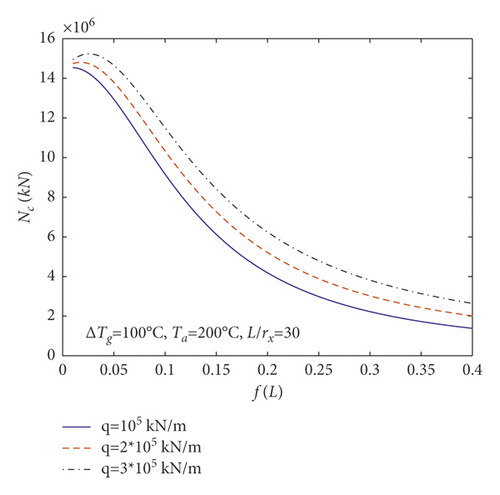
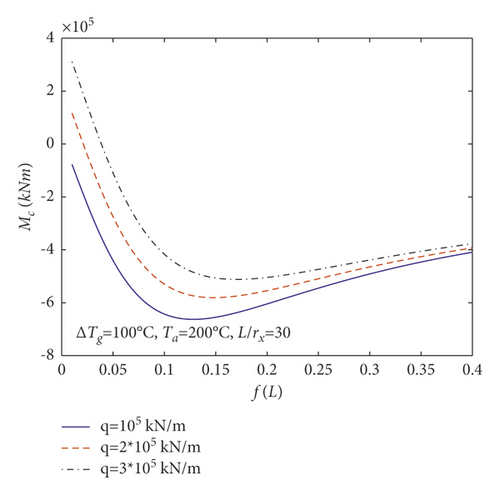
According to Figure 8, the central axial and bending actions Nc and Mc augment as the uniformly distributed vertical load q augments.
Figures 9 and 10 show the variation of the dimensionless internal force with the rise-span ratio for parabolic arch under the linear gradient temperature field and the vertical uniformly distributed load. Figure 9(a) shows that the central axial force Nc augments with the augments of the slenderness ratio L/rx when temperature difference ΔTg = 0°C and the average temperature Ta = 20°C. The central axial force Nc augments as the rise-span ratio f/L augments when the rise-span ratio f/L is less than 0.1 and then decreases as the rise-span ratio f/L augments when the rise-span ratio f/L is bigger than 0.1. Figure 9(b) shows that the central axial force Nc decreases with the augments of the slenderness ratio L/rx when temperature difference ΔTg = 100°C and the average temperature Ta = 200°C. The central axial force Nc decreases as the rise-span ratio f/L augments.
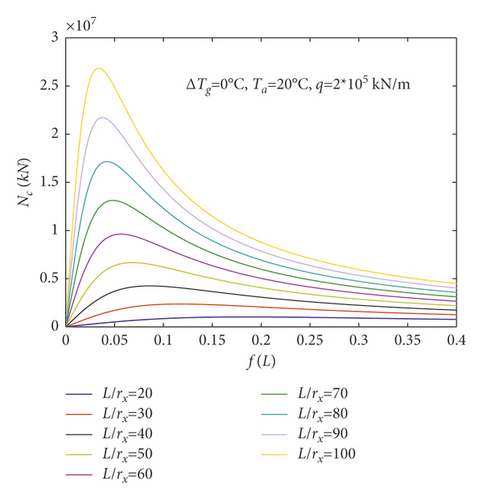
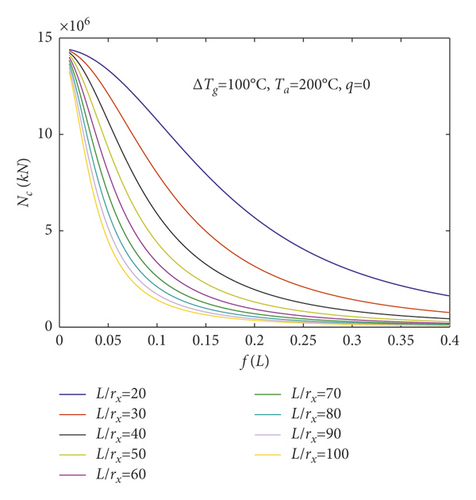


Figure 10(a) shows that the central bending moment Mc augments with the augments of the slenderness ratio L/rx when temperature difference ΔTg = 0°C and the average temperature Ta = 20°C. The central bending moment Mc decreases as the rise-span ratio f/L augments. Figure 10(b) shows that the central bending moment Mc decreases with the augments of the slenderness ratio L/rx when temperature difference ΔTg = 100°C, the average temperature Ta = 200°C, and the rise-span ratio f/L is approximately less than 0.1. The central bending moment Mc decreases as the rise-span ratio f/L augments, while the central bending moment Mc augments with the augments of the slenderness ratio L/rx when the rise-span ratio f/L is approximately bigger than 0.1. The central bending moment Mc augments as the rise-span ratio augments f/L.
3.2. In-Plane Instability Analysis
Equation (35) is the critical in-plane instability load of a fixed parabolic steel arch under the gradient temperature coupled with vertical uniform load.
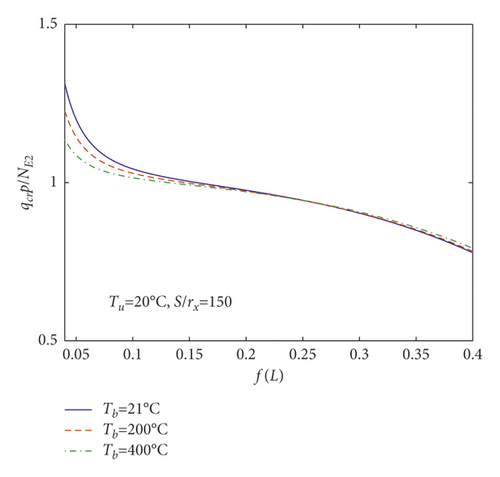
According to Figure 11, when the rise-span ratio is less than 0.15, the dimensionless critical in-plane instability load of parabolic arch is obviously influenced by the temperature gradient field and decreases with the augment of gradient temperature difference. However, when the rise-span ratio is larger than 0.15, the dimensionless critical in-plane instability load of parabolic arch is slightly influenced by the gradient temperature field. In addition, the dimensionless critical in-plane instability load of parabolic arches decreases with the increasing rise-span ratio.
The variation of the dimensionless instability critical load with the rise-span ratio for the parabolic arch under the linear gradient temperature field is shown in Figure 12. As seen from Figure 12, the dimensionless critical in-plane instability load of parabolic arch decreases with the augment of slenderness.
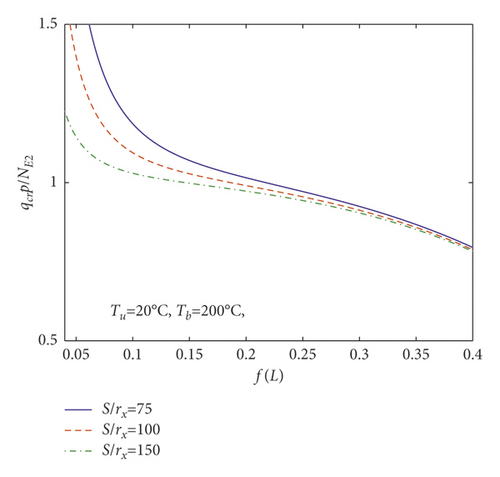
3.3. Finite Element Validation Analysis
Finite element software ANSYS was employed to verify the accuracy of the above theoretical research. A biaxially symmetric I-beam section of the arch has a height h = 250 mm, a width b = 150 mm, a span length L = 5000 mm, a flange thickness tf = 10 mm, and a web thickness tw = 6 mm, and the material properties of Q235 steel were selected for modeling, which can be shown in Figure 13.
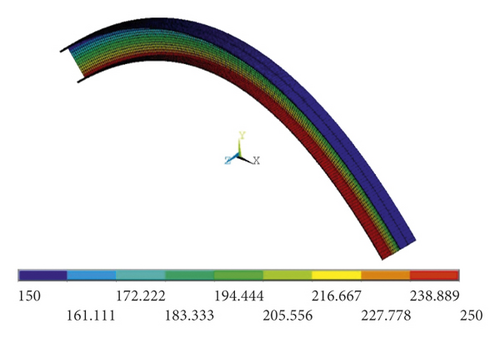
The beam188 element was chosen to build the parabolic arch mode. According to the help file of the beam188 element of ANSYS, the beam188 element can be used to specify temperature gradients that vary linearly both over the cross section and along the length of the element. The model is built and solved numerically for critical loads and then compared and analyzed with the theoretical solution.
The comparison between the theoretical solution and the finite element results for the dimensionless critical in-plane instability load of the parabolic arch under linear gradient temperature field coupled with vertical uniform load can be seen from Figure 14. According to Figure 14, the theoretical solutions agree well with the finite element consequence data, indicating that (35) can accurately predict the instability critical load of the fixed parabolic steel arch under the gradient temperature field coupled with the vertical uniform load.
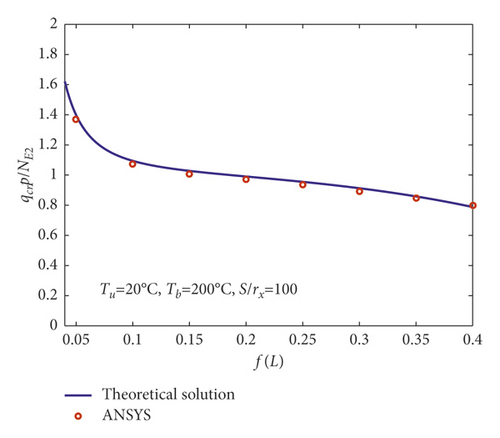
4. Conclusion
- (1)
For parabolic arches under the linear gradient temperature field and vertical uniform load, the central axial force and the central bending moment decrease with the augment of slenderness.
- (2)
The central axial force of the arch first augments with the augment of the rise-span ratio and then decreases with the augment of the rise-span ratio while the rise-span ratio reaches a certain value. The central bending moment decreases with the augment of the rise-span ratio.
- (3)
When the rise-span ratio is less than 0.15, the dimensionless critical in-plane instability load of parabolic arch is obviously influenced by the temperature gradient field and decreases with the augment of gradient temperature difference; however, when the rise-span ratio is larger than 0.15, the dimensionless critical in-plane instability load of parabolic arch is slightly influenced by the gradient temperature field.
- (4)
The dimensionless critical in-plane instability load of parabolic arches decreases with the increasing rise-span ratio.
- (5)
The dimensionless critical in-plane instability load of parabolic arch decreases with the augment of slenderness.
Conflicts of Interest
The authors declare that they have no conflicts of interest.
Acknowledgments
This study was financially supported by the National Natural Science Foundation of China (grant no. 51 908 146) (Experimental Study on GAMECO Aircraft Maintenance Facility Phase III in Guangzhou Baiyun International Airport). The authors are grateful for the support.
Open Research
Data Availability
The data used to support the findings of this study are available from the corresponding author upon request.




